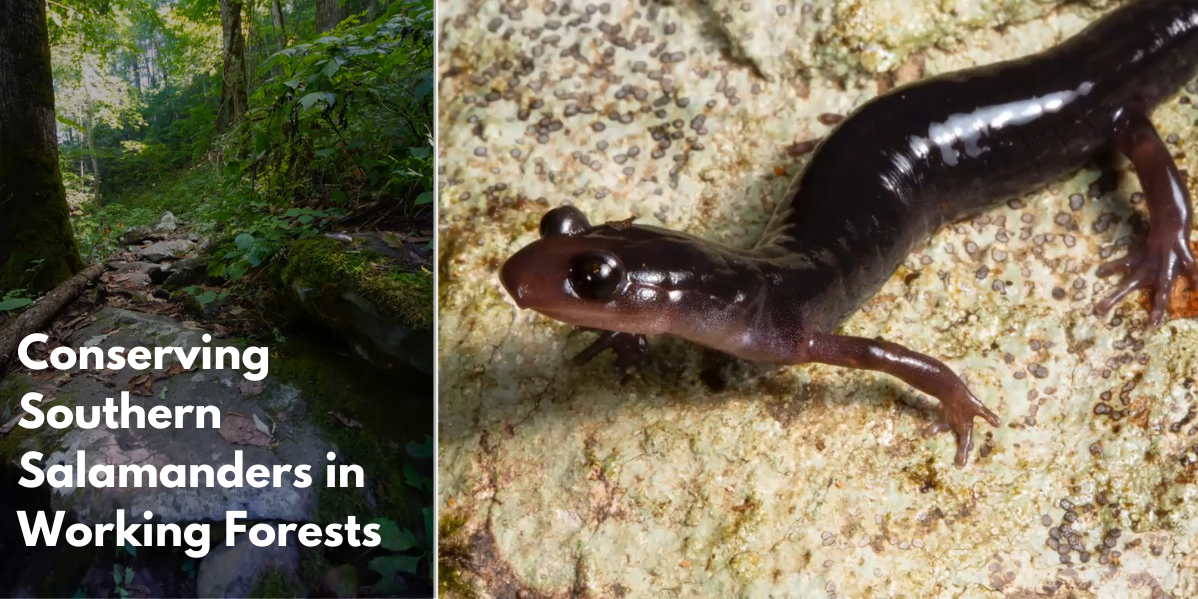Endemic Southern Salamanders

Salamanders in the Southeast
Salamanders and other amphibians play an important ecological role, as they often serve as major links between aquatic and terrestrial systems. Because salamanders have highly permeable skin, they are vulnerable to changing and degraded environmental quality, and this vulnerability is evident when changes to terrestrial systems result in decreased water quality. In fact, salamanders are often considered indicators of quality habitat. One of the most significant threats to amphibians in the Southeast, and to the species that share their habitat, are human activities that result in the degradation and loss of important habitat.
Salamanders are a group of amphibians that are characterized by elongated bodies, short limbs, and moist, water-permeable skin. They are often found in moist, wooded habitats and in or near water sources. The southeastern United States has a higher diversity of salamander species than any other place on earth. Many salamander species are endemic (i.e., native and restricted to a specific location) and over 50 species of amphibians and reptiles are found only in the Southeast.
Species Highlights: Cheoah Bald Salamander
The Cheoah bald salamander only occurs in mesic forests at high elevations on the Cheoah Bald in western North Carolina. It can be identified by its dark gray body and red legs. Adults can be up to 6.7 inches in length. This salamander’s small population size and restricted geographic location make it particularly susceptible to natural and manmade disturbances. This species is currently threatened by habitat destruction mainly due to incompatible forest management such as clearcuts.
Species Highlights: Patch-Nosed Salamander
The patch-nosed salamander may be one of the smallest salamanders in the world. It is a miniature species about one inch long. Adults of this species can be identified by a yellow patch on the snout and a thin yellow dorsal stripe. This species is endemic to headwater streams in steep, mesic ravines of Stephens County, Georgia and Oconee County, South Carolina. Since the patch-nosed salamander spends much of its time in aquatic systems, any operations that affect water quality can detrimentally affect population viability. This species is particularly vulnerable to logging operations that do not follow state BMPs and result in increased sedimentation, increased water temperatures, and all-around decreased water quality.
Further Reading:
Bailey, M.A., J.N. Holmes, K.A. Buhlmann, and J.C. Mitchell. (2006). Habitat Management Guidelines for Amphibians and Reptiles of the Southeastern United States. Partners in Amphibian and Reptile Conservation Technical Publication HMG-2, Montgomery, Alabama. (88 pp.)
Camp, C., Peterman, W., Milanovich, J., Lamb, T., Maerz, J., & Wake, D. (2009). A new genus and species of lungless salamander (family Plethodontidae) from the Appalachian highlands of the south‐eastern United States. Journal of Zoology, 279, 86–94.
Cheoah Bald and Red-Legged Salamanders. (2021). Amphibians and Reptiles of North Carolina.
NatureServe. (2021). Urspelerpes brucei, patch-nosed salamander. NatureServe Explorer.
US Fish and Wildlife Service. (2015, March 15). Additional information on six petitioned species including three salamanders, one lizard, and two insects found in the Southeast. Southeast Region of the U.S. Fish and Wildlife Service.
US Fish and Wildlife Service. (2016). Conserving South Carolina’s At-Risk Species: Species facing threats to their survival. US Fish and Wildlife Service.
Willson JD, Dorcas ME. (2003). Effects of habitat disturbance on stream salamanders: implications for buffer zones and watershed management. Conservation Biology. 17(3):763–771.
Resources
Stay Informed
about our recent projects and upcoming events.
